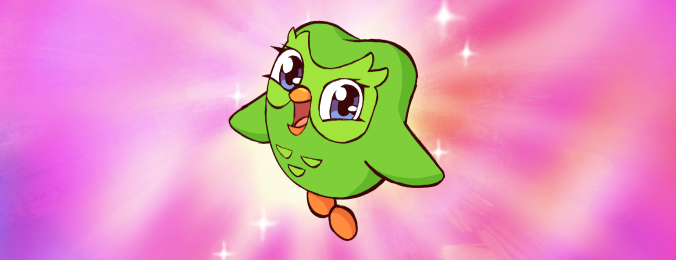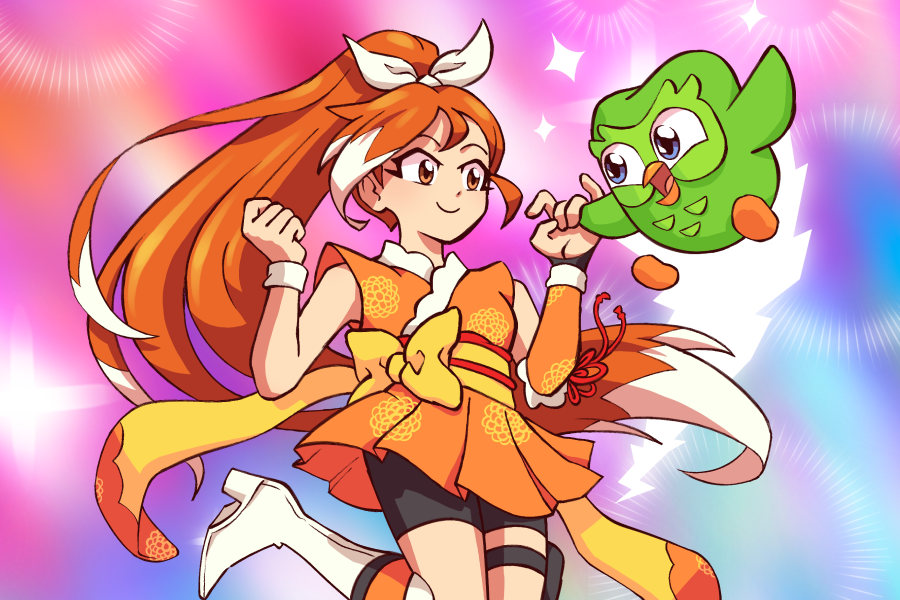Using TV and movies to enhance your language learning is a great strategy for staying motivated, and Japanese learners are in luck! Anime is packed with linguistic and cultural nuances that will complement your learning journey.
Here are 3 things about Japanese you'll learn from anime.

Lesson 1: How to use Japanese pronouns to represent (and play with!) identity
In English, we have just one pronoun for the first-person singular, "I"—but in Japanese, there are many options, and they all convey something a little different about the speaker! The different pronouns Japanese speakers and anime characters use—and whether they use a pronoun at all— says something about their gender expression and even the degree of gender expression, like are they trying to convey masculinity or aggressive masculinity? Here are some of the options you'll hear:
| Listen out for | How it's used | Example 📺 |
|---|---|---|
| Person's first name (used instead of a pronoun) |
Not common besides among children, since it comes across as trying to act "cutesy" Feminine-sounding Can also come across as self-important and egotistical |
Anya from Spy x Family is an actual child who uses her first name instead of a pronoun. She also regularly flubs various words, as you might hear a child do Dio Brando from Jojo's Bizarre Adventure is a villain who often refers to himself with his own name for dramatic effect–sort of like how saying "I, Dio Brando!" sounds grandiose in English |
| 私/わたし watashi |
Most common pronoun for polite speech, and the most common pronoun for female characters speaking casually Feminine-sounding in casual speech but is used by everyone in more polite speech Can be pronounced as watakushi in very formal situations |
L from Death Note speaks politely as uses the neutral watashi |
| あたし/アタシ atashi |
Normally used casually, rare to find with polite speech More casual or girlish-sounding than わたし (watashi) |
Usagi (Sailor Moon) from Sailor Moon Sayaka and Kyoko from Madoka Magica |
| 僕/ボク boku |
Normally used casually, uncommon to find with polite speech but could happen in less formal situations Masculine-sounding but more on the boyish or bookish side (softer, gentler masculine expression) |
Deku from My Hero Academia (in Japanese, 僕のヒーローアカデミア, "Boku no Hero Academia") Muichiro from Demon Slayer Ken from Tokyo Ghoul Light Yagami from Death Note Haruka (Sailor Uranus) from Sailor Moon |
| 俺/オレ ore |
Normally used casually, rare to find with polite speech Used by many male protagonists, especially in the action genre More masculine-sounding than 僕/ボク (boku), gives an assertive or "tough guy" image |
Most of the male cast of Demon Slayer Most of the male classmates in My Hero Academia |
There are also playful examples from anime of how characters use and change their pronouns.
- In Tomo-chan is a Girl! the character Tomo is a tomboy who has expressed herself in a very masculine way since childhood—she used to use オレ (ore—the last one in the chart) when growing up.. This contributes to the main drama in the plot: Her crush treats her as just "one of the guys"! Now in high school, Tomo is still a tomboy but now uses アタシ (atashi) in combination with masculine-sounding language, like ending sentences with ぞ (zo) or ぜ (ze).
- Your Name is a Freaky Friday-style anime movie about two strangers who mysteriously switch bodies… so naturally they have to figure out the new body's pronouns! Mitsuha, a small-town girl, is now in the body of Taki, a city boy. In one scene, Mitsuha is eating lunch with Taki's friends and uses the feminine 私 (watashi), then in a panic tries the formal 私 (watakushi), then 僕 (boku)... until finally she gets the correct one: 俺 (ore)!
Lesson 2: Differences in Japanese dialects
Like all languages, there are different dialects and accents across Japan, and advanced learners can listen for them across anime!
One of the most common non-Tokyo accents you'll hear is from the Kansai area of western Japan, where Osaka and Kyoto are. The Kansai dialect can have…
- Different intonation: Standard Japanese intonation in the word ありがとう (arigatou, “thank you”) rises in the middle (aRIgatou) while Kansai dialect rises at the end (arigaTOU)
- Unique vocabulary: あかん (akan, “Oh no!” or “That’s not good!”)
- Different sentence endings: や ya instead of だ da for “to be”, or -へん (-hen) instead of -ない (-nai) for negative verb endings
You can hear Kansai Japanese from Himuro on The Ice Guy and His Cool Female Colleague—he mostly uses standard polite Japanese with his work colleagues, but in monologues or when he's excited, he slips into Kansai dialect! In contrast, Aoi from Laid-Back Camp uses Kansai dialect all the time with everyone. Kero, the magical companion from Cardcaptor Sakura is actually voiced by an actor from Osaka, so you'll also hear Kansai from him.
As you keep studying Japanese, you'll get even more out of the nuances of how characters speak!
Lesson 3: The casual Japanese you'll need for natural conversations
Anime is a great way to learn casual words and expressions you'll hear in real conversations between Japanese speakers! Here are 4 useful phrases you'll hear a lot in anime:
- やばい/ヤバい (yabai). Yabai has been used in Japanese for decades, but more recently it's gained a new meaning with a more positive interpretation. It started out as an adjective meaning "dangerous" or "awful," or even "oh no," but now it can also be used to mean "cool" or "amazing." It's used to show when something is really… well, really anything! It shows degree, so something that is really good, really bad, really cool, really annoying, etc. You can see how versatile this one word is! How yabai is that? 😳
- マジ (maji) or マジで (maji de). Maji is used the way we use "for real," "seriously," or "totally" in English. You might hear someone ask マジで? (Maji de?) to ask "For real?" It also adds emphasis to a whole sentence, as in マジムカつく!(Maji mukatsuku), which means "This is totally getting on my nerves!" (literally “I am seriously feeling angry”).
- じゃん (jan). Jan is used at the end of a sentence to give emphasis, the way we might say "right?" or "I'm telling ya!" at the end of a sentence in English. It's an informal contraction of the phrase じゃないですか (janai desu ka, literally "isn't it?"), which can be used as a rhetorical question when you just want to express your opinion. じゃん (jan) can be used to say やるじゃん! (yaru jan) for "Wow, way to go!" or いいじゃん! (ii jan) to say "That's great!"
- さ (sa). Sa can be a filler used to show that the speaker is still talking, just like how we use "you know" and "like" in English. You might hear それでさ... (sore de sa) for "And then like…" and you can say 最近さ、アニメ見ててさ… (saikin sa, anime mitete sa…) for "Recently, like, I've been watching anime and like…" And just like in English, it can be considered annoying to overuse it!
Another kind of casual Japanese you'll hear a lot in anime is a way Japanese speakers give emphasis and show emotion: dropping the -i from adjectives that end in -i. Adjectives like やばい (yabai—which we discussed above!), 怖い (kowai, "scary), and 寒い (samui, "cold") are shortened to やばっ (yaba, "Whoa, that's yabai"), 怖っ (kowa, "Whoa, that's scary"), and 寒っ (samu, "Whoa, it's cold). This -i dropping only happens if the adjective ends in a single -i, so you can't shorten おいしい (oishii, "tasty") or 大きい (ookii, "big").
Duo's favorite anime
Our Japanese course has been around for six years! To celebrate, we've teamed up with Crunchyroll, a global anime brand and streaming platform that houses the world’s largest anime library. Duo made a list of his favorite anime shows on Crunchyroll’s platform!
1. Bananya, a series of anime shorts typically aimed at children, but great for beginner learners!
2. Free! Iwatobi Swim Club, a sports anime featuring a high school swim club.
3. Hyouka, a romantic-mystery combo that uses a lot of everyday vocabulary learners will recognize.
4. Laid Back Camp, a fun series about, you guessed it, very laid-back campers!
5. Nichijou, a surreal comedy featuring three ordinary girls, featuring good examples of casual conversation.
See the full list of Duo’s favorites here.
Animate your Japanese learning with anime!
Anime is an especially fun learning tool for Japanese learners, and there's so much language and culture to uncover no matter your level—マジで (maji de)!!
